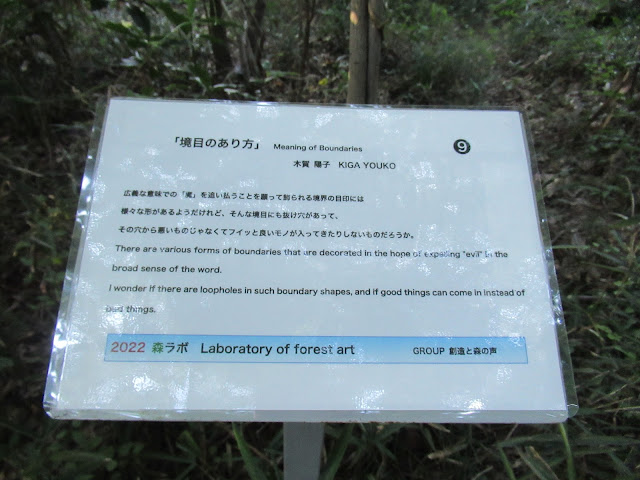Now this is the time for my annual adventure with the art show by Laboratory of Forest Art. They opened their door on 18 September for 2022, when the mega Typhoon Nanmadol is encroaching from the west to Yokohama. Already on September 18 we had down pouring and the water level of Meguro River running in Setagaya, Meguro, and Shinagawa Wards of Tokyo reached high enough for flood warning. I happened to visit their forest just before the typhoon, when the sky was calm yet. The artists almost resigned for the fate of their installation under the coming storm while they put the final touch … er, no, I must say they were optimistic in a sort of enlightened way. Nature is nature, and we just think how to live happily with the Mother. This may have been their attitude. It could be a radical difference from their art in earlier days (; my posts on August 30, 2016, for example). The key here might be in Mr. Akatsuki Harada’s word. “Hi, Naomi. You know, this year’s show is like how to talk with Oak Wilt Disease.” Hmmmm. Anyway, better start showing first my photos of their installations for 2022 Laboratory of Forest Art (9/1/-10/23, 2022). The manifestation for each artwork can also be found in their Homepage.
 |
| Map for 2022 Laboratory of Forest Art. You can get the paper version at the entrance. |
Noriaki Oka: Flower Path
Asayo Yamamoto: Drops of Moon
ASADA: Dragon’s Nest
Kana Tatekawa: Cry
Haruna Chikada: Camouflage of B
 |
| Concentrating Haruna |
 |
| When we go through the avenue of wild Cardiocrinum cordatum … |
Toshikazu Kanai: the Journey of Ruined Boat II
Kazuo Ishikuro: Dancing on a Stump
Ishikuro sculpted his work straight out of a stump of oak thinned due to the oak wilt. The sculpture is “sprouted” from the remain of the tree like suckers for healthy tree. We cannot move it an inch. He said “You know, normally for this size of work we move the material and stabilize the position of our hands to chisel. This time, nah. I myself rolled about the ground around the stump to have a good point. I devised a longer graver but still could not reach to the bottom.” Please enjoy how his chisel-work goes with the forest.
 |
| By the way, last year’s Helper Tower-Human is well for 2022 (; my post on October 8, 2021). |
Naoko Kobayashi: Yokohama Wild Grass Garden – Dream of Quercus Serrata
 |
| For Naoko’s concern, at least Hylodesmum podocarpum and |
 |
| Desmodium podocarpum this year are formidable there. |
Youko Kiga: Meaning of Boundaries
 |
| Youko was busy for her final touch. |
 |
| The “boundary” was harvested from here. Destroying forest? Not so fast. I’ll post a story about Trachycarpus in Yokohama’s forest soon. |
Yoshiki Takata: Regard / R(e)ga:r
Youichiro Yoshikawa: the Lordless Garden
 |
| And then, Kazuo Ishikuro’s “Giant Mori Mori (2021)”
is invading the Lordless Garden! The spirit of reptile said it would come and go until COVID mess settles in some way. |
Noriaki Oka: Flower Path
 |
| Yeah, and there are lots of mushrooms busy decomposing the fallen trees this year in their forest … |
Akatsuki Harada: Image of the Giant Tree
 |
| Ms Iino’s directions show us the way by eyes. |
 |
| Mr. Ishiyama’s giant pencil, with mashrooms |
 |
| Here be dragons by Kimihito Zama. |
If you find a problem in the site introduced in this post, the best contact address will be GROUP the Creation and Voice of the Woods.
https://morilab.amebaownd.com/
e-mail: morinokoe7@yahoo.co.jp
The city office which is in charge of this forest is
Office for the Park Greeneries in the North 北部公園緑地事務所
Yokohama Municipal Government Creative Environment Policy Bureau 横浜市環境創造局
Phone: 045-311-2016
FAX: 045-316-8420





























Hi all, Naomi here,
ReplyDeleteI’ve received very practical information about fungi cultivation from a comment sent by Delun after reading this post. Though, I thought I have to tell all of you a warning about the oak tree wilt and fungi, as this is a very dangerous combo in any forest. First, I don’t recommend Raffaelea quercivora, the culprit fungi for oak tree wilt, for your mushroom farming … It would devastate your garden, park, forest, you name it, until the ambrosia beetle (the vector carrying the fungi for oak tree wilt) lose properly sized tree for their home-sweet-home in the forest … the insects need such living tree for their procreation, and thus spread of Raffaelea quercivora consequently, you know. For more about the devastation by fungi Raffaelea quercivora and Japanese forest, please check my previous posts from August to September 2019. Regarding the Raffaelea quercivora and fungi, after trees fell due to the disease by Raffaelea quercivora, there often sprout mushrooms named Podostroma Cornu-damae, very peculiarly shaped fungi that is uber-poisonous. It can cause severe inflammation and erosion over your skin just by touching it. If you eat it, you’ll die within a couple of days after extreme writhing in agony. Fortunately, I haven’t met it in the forest I visited, but tons of my friends who love outdoors have spotted this autumn the red monster in all over Kanagawa Prefecture. It is due to the destruction by Raffaelea quercivora and oak tree wilts in Kanagawa’s forest. The governments (from national to town halls) of Japan this year ask anybody who found the mushroom to report the sighting ASAP. They will dispatch a special emergency squad to remove it. Please be careful, really, for this mushroom while you enjoy early winter forests in Japan …